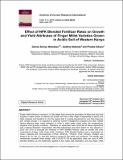Effect of NPK Blended Fertilizer Rates on Growth and Yield Attributes of Finger Millet Varieties Grown in Acidic Soil of Western Kenya
Publication Date
2017Author
Dennis Simiyu Wamalwa, Godfrey Netondo, Phoebe Sikuku2017
Metadata
Show full item recordAbstract/
Finger millet (Eleusine coracana L) is the staple food among the population of Africa and Asia that supplies a major portion of calories and protein and has a wide range of adaptability to abiotic and biotic stresses and therefore it is for this reason that it is being popularized to curb food insecurity and climate change. It is important to optimize nutrient management practices and other related factors affecting finger millet cultivation in order to attain better yields under the comparatively marginal local growing conditions. Therefore, an experiment was conducted at Kenya Agricultural and Livestock Research Organization (KALRO) Kakamega crops field station for two seasons in 2015 and 2016 to evaluate the influence of NPK blended fertilizer rates on growth and yield components of finger millet under acidic conditions. NPK blended fertilizer has a combination of macro nutrients and micronutrients, (10%N, 26%P2O5, 10%K2O, 4%S, 8%CaO, 4%MgO and traces of B, Zn, Mo, Cu, and Mn) making it unique to this acidic soil conditions. The design was randomized complete block design, with 0,25,50,75,100 kg application rates per acre of NPK blended fertilizer as the treatments applied in two equal split application and two finger millet varieties (P-224 and Gulu-E). The period to 50% flowering was significantly reduced due to the application of NPK blended fertilizer where Gulu-E had 80 days at the highest rate while P-224 had 81 days on the same rate during the long rainy season. At 50 kg/acre, the number of days to physiological maturity were significantly reduced under both varieties where Gulu-E took 107 days to mature during the long rainy season. The number of productive tillers was increased with increasing NPK blended fertilizer application rate especially under Gulu-E variety with a high number of 42 productive tillers per plot. The grain yield was significantly increased by application of NPK blended fertilizer with the peak observed at the 75 kg/acre rate for both varieties but Gulu-E outperformed P-224 for both seasons. The study concludes that application rate of 75 kg/acre of NPK blended fertilizer leads to the highest grain yield potential of finger millet and has great liming effects that ultimately reduces the acidity of soils in the western Kenya region.
Collections
- Department of Botany [232]

